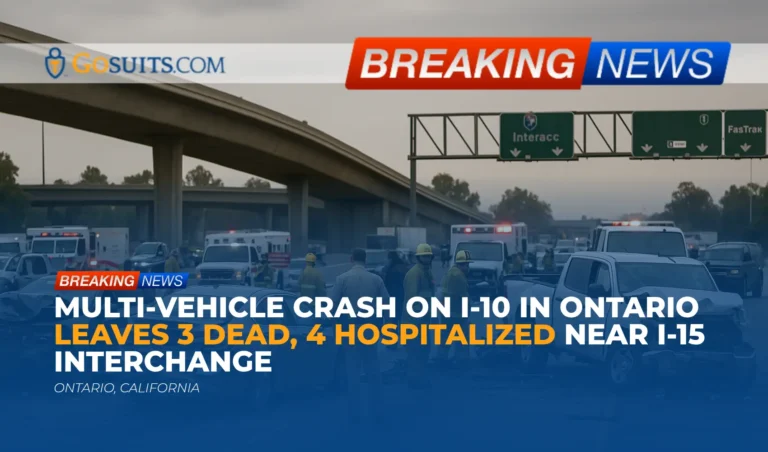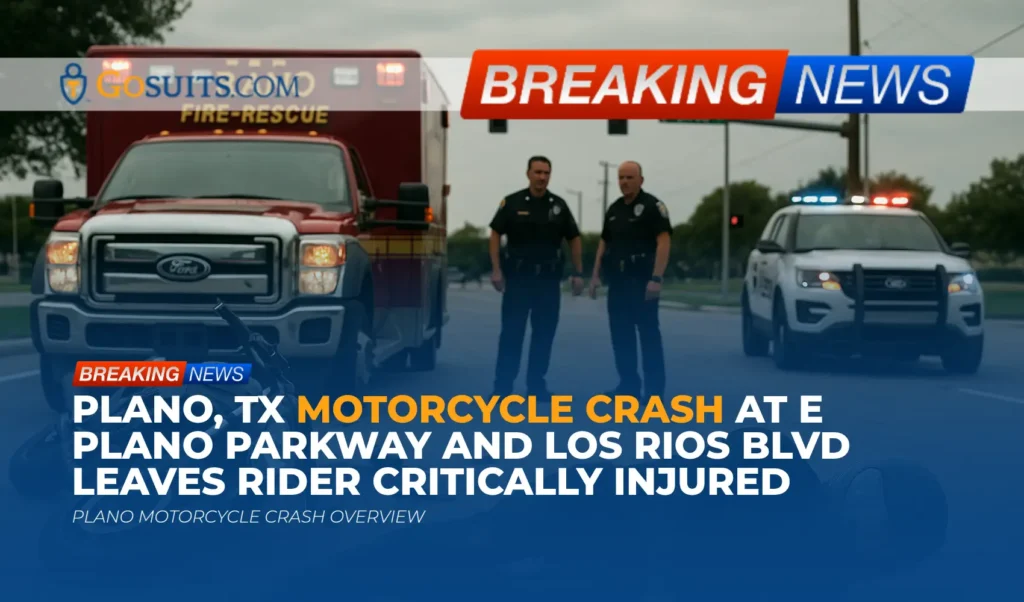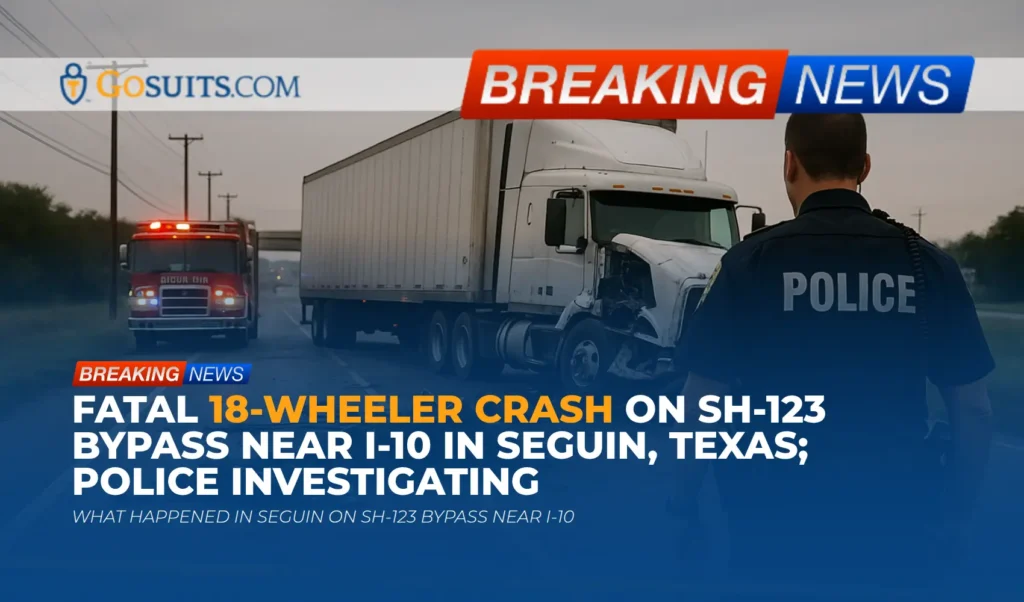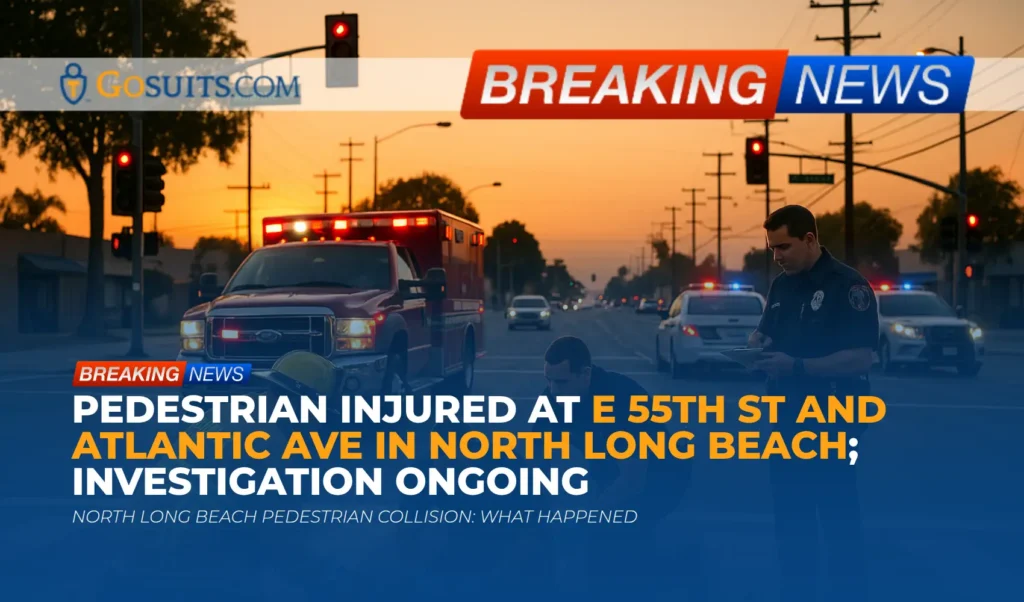- Summary of the reported crash on I-10 in Ontario
- What is known so far from responders
- Immediate steps families can take after a serious freeway crash
- How to obtain key records in and around Ontario and San Bernardino County
- How multi-vehicle crash investigations proceed on California freeways
- Possible civil liability in multi-vehicle freeway collisions
- Insurance considerations after a deadly or serious collision
- Deadlines and time limits under California civil law
- Safety context and statewide data
- Preserving evidence and why timing matters
- Government resources and agencies that can help
- Why acting promptly matters
- Commentary from Gosuits Ontario, California Personal Injury Attorney
Summary of the reported crash on I-10 in Ontario
According to reporting shared the morning of October 22, 2025, a multi-vehicle collision on westbound Interstate 10 in Ontario, California, resulted in three fatalities and four people being hospitalized. California Highway Patrol units responded at about 1:15 p.m. Pacific Time to the area just west of the Interstate 15 interchange. First responders pronounced two people deceased at the scene. Five additional adults were transported to nearby hospitals, and one of those individuals was later declared deceased by hospital staff. The conditions of the remaining injured people were not immediately known. A SigAlert was issued, most westbound lanes were closed except for FasTrak, and the I-10 to I-15 connector was shut down for an extended period due to heavy traffic and delays. Ontario Fire Department personnel assisted at the scene. The precise sequence of events and contributing factors were not released at the time of the report.
For those who are grieving or anxiously waiting for updates, please know this overview is shared with care and respect. When information is limited, families can still take meaningful steps to understand what happened and to protect their rights as more facts emerge.
What is known so far from responders
Based on the initial public reporting:
- Location: Westbound I-10, just west of the I-15 interchange, within the Ontario area of San Bernardino County.
- Time: Approximately 1:15 p.m. Pacific Time on a Tuesday afternoon.
- Victims: Three adults deceased, four adults hospitalized. Identities, ages, and hometowns were not released at the time of reporting.
- Agencies: California Highway Patrol responded and managed traffic control and the investigation. Ontario Fire Department provided emergency medical response and transport.
- Traffic control: A SigAlert was issued. All westbound lanes except FasTrak were closed for a period, and the I-10 to I-15 connector ramp was closed while crews worked the scene and investigators documented evidence.
- Cause: Not yet stated. When CHP completes its investigation, collision reports may provide a crash diagram, involved parties, witness statements, and preliminary factors like unsafe speed, inattention, impairment, mechanical failure, or other hazards.
In the early phase of a freeway investigation, CHP typically secures the scene, renders aid, documents vehicle positions and roadway evidence, canvasses for witnesses, and coordinates with towing and cleanup. If a fatality occurs, a coroner’s office is notified to manage next of kin notifications and postmortem examinations.
Immediate steps families can take after a serious freeway crash
It is difficult to balance grief with the practical steps that follow a sudden loss or serious injury. These actions can help families obtain clarity without adding unnecessary strain:
- Identify the investigating office. Determine which CHP Area Office is handling the crash and the report number if available. This will be needed to obtain the collision report later.
- Keep important documents together. Store any hospital discharge papers, paramedic forms, towing receipts, and personal property inventories in a safe folder. Photograph items before returning them to storage.
- Write down what you know. As soon as possible, note the date, time, location, lane, direction of travel, weather, and any calls you received. Names and numbers of witnesses or bystanders are especially helpful.
- Preserve phones and vehicles. Do not erase texts or social media messages about the crash. If a vehicle is involved, ask the tow yard to hold it and not release it for salvage until you understand your options. Vehicles often contain critical crash data.
- Consider professional guidance. Before speaking to any insurer, including your own, consider seeking a free consultation with a qualified attorney who handles serious traffic collisions. What is said to an adjuster can be used later, and early choices affect outcomes.
How to obtain key records in and around Ontario and San Bernardino County
CHP traffic collision report
On California freeways, CHP is typically the primary investigating agency. Families and injured people can request a copy of the Traffic Collision Report, usually by completing a CHP 190 request form and submitting it to the Area Office that investigated the crash. CHP provides instructions on requesting collision reports and how to locate the correct office.
Collision reports often include a narrative, a diagram of the scene, involved parties and insurance listings, witness statements, injury classifications, and preliminary factors. Supplemental reports may follow if the investigation continues.
Coroner, autopsy, and cause of death documents
Ontario is within San Bernardino County. When a fatality occurs, the San Bernardino County Sheriff’s Department Coroner Division manages decedent identification, next of kin notification, autopsy and toxicology when indicated, and the death certificate process. Families can contact the Coroner Division for information on case status and procedures for requesting autopsy and toxicology reports once available.
Final autopsy and toxicology results can take weeks. A preliminary cause of death may be listed on the death certificate sooner, with amended certificates issued if needed.
Death certificates
Certain relatives can request certified copies of a death certificate through the county’s Assessor-Recorder-Clerk once the coroner and physician complete the certificate. Certified copies are often needed for estate and insurance matters.
Roadway closure and incident information
For situational awareness, Caltrans provides live maps of closures and incidents. This can help track when lanes reopened and may be relevant to timelines.
911 recordings, radio traffic, and CAD logs
Depending on agency policies and California’s Public Records Act, certain audio recordings and dispatch logs may be available upon request. Availability is subject to exemptions for active investigations and privacy. Families can inquire with the investigating CHP Area Office about whether any Computer Aided Dispatch logs can be requested after the investigation phase, and with local public safety communications centers for 911 recordings if applicable.

How multi-vehicle crash investigations proceed on California freeways
Multi-vehicle collisions on high speed corridors like I-10 require a careful reconstruction to determine how the crash unfolded. Investigators commonly examine:
- Vehicle positions and damage. Crush patterns, underride or override marks, and contact points can show sequence of impacts.
- Roadway evidence. Skid marks, yaw marks, debris fields, fluid spills, and gouge marks help estimate speeds and final rest positions.
- Environmental conditions. Lighting, sun angle, wind, and pavement conditions are documented.
- Driver factors. Distraction, impairment, fatigue, and decision making are assessed through interviews, observations, and toxicology where appropriate.
- Mechanical and cargo issues. Tire failure, brake condition, unsecured loads, and vehicle defects are evaluated when suspected.
- Electronic data. Many newer vehicles store event data such as speed, throttle, braking, and seat belt use that can be downloaded and analyzed. See NHTSA resources on event data recorders.
On freeway incidents with fatalities, full documentation can take time. Preliminary determinations may change as new information arrives, and supplemental reports are common. Families should expect an initial collision report, and sometimes follow up reports if significant findings are added.
Possible civil liability in multi-vehicle freeway collisions
Every crash is unique, and liability depends on facts revealed by the investigation. In general, civil liability after a multi-vehicle collision may involve:
- Negligent drivers. A driver who followed too closely, made an unsafe lane change, drove at an unsafe speed for traffic, or failed to yield may be responsible for resulting injuries and losses under California negligence standards.
- Commercial carriers. If a tractor trailer or commercial vehicle is involved, the company that owns or operates the vehicle can be responsible for the conduct of its driver and for independent negligence such as negligent hiring, training, supervision, or maintenance. Safety performance data for motor carriers can be reviewed using federal resources like the FMCSA Safety Measurement System.
- Third parties. Loading companies, maintenance contractors, or entities responsible for cargo securement can share fault if unsafe practices contributed to the crash.
- Public entities. On rare occasions, a dangerous roadway condition that an agency knew about and failed to correct can support a claim, subject to strict timing and immunity rules. Claims against public entities have shorter deadlines than ordinary claims.
- Product failure. Defective components like tires or brakes can contribute to collisions. Product cases require technical investigation and preservation of parts.
Families pursuing wrongful death claims in California can generally seek compensation for losses permitted by law, which may include funeral expenses and certain non economic harms, and in some situations the estate can pursue a survival action for damages the person could have recovered had they lived. The available categories depend on the statutes and the facts.
Insurance considerations after a deadly or serious collision
Insurance issues often become complicated after multi-vehicle crashes. Some points to consider:
- Liability insurance of at fault drivers. Each negligent driver’s liability coverage may be a source of recovery. Multiple claimants and limited policy limits can create competition for funds.
- Commercial policies. If a commercial vehicle is involved, there may be higher limits and multiple policies, including motor carrier liability and umbrella policies.
- Uninsured or underinsured motorist coverage. California drivers can carry UM or UIM coverage that may apply when an at fault driver has no insurance or insufficient limits. Policy terms control whether and how these coverages apply.
- Medical payments coverage. MedPay may help with medical expenses after a crash regardless of fault, depending on the policy.
- Life and accidental death policies. Private policies or employer provided benefits may be available. Claims generally require a death certificate and sometimes coroner documents.
Before speaking to any insurer or giving a recorded statement, consider consulting an attorney who handles serious collision cases. Adjusters may ask questions that seem routine but are designed to limit exposure. Statements and signed authorizations can affect claims later on. In California, there is no requirement to provide a recorded statement to an opposing insurer. Even with your own insurer, you have duties of cooperation under the policy, but it can be wise to obtain guidance before any detailed statement. What is said can be used against you later.
Deadlines and time limits under California civil law
California law imposes time limits for filing civil cases and for claims against public entities. Missing a deadline can end a claim regardless of its merits. The following general time limits are commonly relevant, though exceptions can apply:
- Personal injury and wrongful death. Most personal injury and wrongful death actions must be filed within two years of the injury or death. See Code of Civil Procedure section 335.1.
- Claims against public entities. When a claim is asserted against a state or local public entity, a written claim typically must be presented within six months for claims related to personal injury or death. See Government Code section 911.2. Additional rules govern claim rejections and the timeframe to file suit.
Because exceptions exist and the timeline can be affected by many factors, consider obtaining a free consultation promptly to understand how these rules apply to your situation.
Safety context and statewide data
While the cause of this Ontario crash has not been released, statewide data offers context about freeway safety risks:
- National fatalities. NHTSA’s preliminary estimates indicate that 42,514 people died in motor vehicle crashes in 2022 nationwide. See NHTSA’s Fatality Analysis Reporting System and related summaries at NHTSA FARS.
- California fatalities. California has consistently reported several thousand traffic fatalities annually. The California Office of Traffic Safety provides data summaries and trend information. See OTS road safety facts.
- Common factors. Speed, impaired driving, distraction, and occupant protection remain key factors in severe injury and fatal crashes, according to NHTSA and OTS research.
Freeway corridors that handle heavy commuter and freight traffic, including the I-10 and I-15 corridors, see complex crash patterns involving multiple vehicles. These events often require in depth reconstruction to pinpoint responsibility.
Preserving evidence and why timing matters
Evidence can change or disappear quickly after a crash. Steps that can protect the truth include:
- Vehicle preservation. Vehicles may be released to insurers or tow yards for sale or salvage. If litigation is anticipated, a preservation notice asking that the vehicle be held can protect the event data recorder and mechanical components for inspection.
- Scene evidence. Skid marks fade and weather erases debris. Early scene photographs and measurements are valuable. Caltrans timelines of closures and CHP logs can anchor timing.
- Electronic records. Cell phone data, dashcams, and commercial vehicle telematics may require prompt requests to prevent routine overwriting.
- Witnesses. Contact information should be confirmed as soon as possible, while recollections are fresh.
If a commercial motor carrier is involved, federal regulations and company retention policies can affect how long logs, inspection records, and telematics are stored. Early notice helps ensure critical materials are not deleted in the ordinary course of business.
Government resources and agencies that can help
These official resources can help families locate records and stay informed:
- California Highway Patrol
- San Bernardino County
- Sheriff Coroner Division for autopsy and coroner case information
- County departments including Recorder for death certificates
- Caltrans
- QuickMap for closures and incident data
- NHTSA
- California Office of Traffic Safety
- FMCSA
- Motor carrier safety profiles where a commercial vehicle is involved
If you are unsure which CHP Area Office handled the crash, the “Find an Office” tool helps locate contact details by region. Staff can verify if their office prepared the report and advise on the request process.

Why acting promptly matters
What is the exact thing the audience should do
- Document and preserve. Secure vehicles, keep all paperwork together, and write down what you know while details are fresh. Ask tow operators to hold vehicles until you decide on next steps.
- Identify the investigating office. Confirm the CHP Area Office and obtain the report number if available. This makes requesting records smoother later.
- Avoid early statements. Refrain from recorded statements to any insurer until you have received guidance. Early statements can limit options later.
- Calendar deadlines. Mark potential time limits, including the two year civil filing period and shorter public entity claim windows, so rights are not lost by delay.
Consider what benefit or outcome they will get by acting. Explain the urgency and expand with context
- Evidence is perishable. Vehicle data can be overwritten, tow yards can release vehicles to salvage, and roadway evidence fades quickly. Early preservation strengthens any investigation.
- Multiple claimants. In multi-vehicle collisions, many people may be drawing from a limited pool of insurance coverage. Early action can position claims for fair evaluation.
- Public entity timelines. If a roadway condition or state vehicle may be implicated, the six month government claim deadline can pass quickly.
- Clarity for families. Proactive steps help families receive timely answers about what happened and why, which can bring some measure of certainty during a painful time.
Commentary from Gosuits Ontario, California Personal Injury Attorney
Our hearts go out to everyone affected by the multi-vehicle crash reported on I-10 in the Ontario area. Losing a loved one or facing a sudden hospitalization is devastating. This commentary is intended for general information and education, and it is not a substitute for personalized guidance.
Based on what is publicly known, investigators will likely focus on how traffic was flowing westbound, what triggered the initial impact, and whether following distances, lane changes, speed, or other factors cascaded into a multi-vehicle event. Freeway interchanges like I-10 and I-15 carry heavy volumes and complex merging patterns. In such settings, one unsafe decision can create a chain reaction that leaves little time for others to respond. When the causes are unclear at first, it becomes even more important to preserve vehicles and obtain complete reports so families can learn the truth.
In our experience, insurance companies and large corporations often act quickly to protect their financial exposure. Adjusters may seek recorded statements and medical authorizations early on, and they may push for quick resolutions before the full impact is understood. This is especially challenging for families who are grieving or who are juggling medical crises. Early statements can be used against claimants later, and accepting a quick settlement can close the door on future recovery if later discoveries reveal broader harms or additional responsible parties.
A free consultation can be an important first step to understanding rights, the timeline, and the practical steps needed to preserve evidence. It gives people a chance to ask questions, to learn how insurance coverages may apply, and to plan how to obtain and interpret key records like the CHP collision report and coroner documents. Even if no immediate decisions are made, an informed plan can make a meaningful difference in the months that follow.






